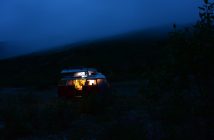Vanlife is a free and beautiful way of alternative living. It’s also rapidly gaining popularity, but our society is not made for it. We can only live in our van because most other people don’t. What does the rising popularity of vanlife mean? And what would happen if we all moved into our vans?
I tap the sunset-colored camera icon on my phone screen. It gives birth to a black rectangle that quickly expands over the display and turns into the Instagram home screen, at least once my aging phone has figured out the details of this seemingly very complex process. I scroll through my feed. Some images I swipe away quickly, some capture my attention, I stop and study the image, take in the details I didn’t see at first glance. Scrolling through the pictures I realize: almost my entire feed is filled with vanlife.
I scroll past Vanagons riding through snowy Pacific Northwestern forests, Chevy vans before gorgeous Californian cliffs, Baywindow buses before equally gorgeous Australien cliffs, a shorty schoolbus on a lonesome desert dirt road. Some of the pictures have people in them, some just the cars in beautiful scenery, all of them are good photographs (we ourselves have noticed that the most successful pictures on our Instagram account mostly show the Bus in beautiful scenery. Photos with us in it are received alright, but what people really want to see – it seems – is Big Emma). That’s what Instagram is about and what we as the vanlife community use it for: to show the good sides of our lifestyle. The wonderful landscape that surrounds us, the surreal beautiful places we get to wake up in, the beach life we can enjoy while the Northern hemisphere is shivering through another winter. We emphasize the good parts, and who wouldn’t?
We had no idea what we were getting ourselves into
When we joined the vanlife tribe in June last year, we did so in ignorance. We knew of other people traveling to South America in their buses and vans, but we weren’t aware of the existence of a huge vanlife community in the United States. For us, it began as a trip with a starting line and a finish. It was the journey across the Americas in the Bus that we decided to do, and the lifestyle just came as the natural by-product.
And then, as we met more and more other van-dwellers on the road, we realized that there is another, much more common approach to vanlife: for most people, it starts with the idea of living in a vehicle, with the freedom of being able to move around, but not with a set destination. Vanlife is much more commonly a way of life, rather than a mode of transportation. I almost feel silly writing down such a plain and obvious truth, but back in June when we were still green behind our vanlife-ears, this came as quite the realization.
Vanlife’s skyrocketing popularity
And as a lifestyle, vanlife is rapidly gaining popularity. From its roots as a poor bum’s version of massive American motorhomes, vanlife has evolved in a few short years to be a hip and modern way of redefined living. The reduced space and carbon footprint, the mobility it provides, the affordability of the lifestyle are key factors in its rise in popularity. New trends like tiny houses and the rebirth of camping as a hip way to explore the outdoors go alongside the rise of vanlife.

Vanlife events like Descend on Bend see huge gains in popularity. Last year saw a gathering of about 80 vans, which grew this year to over 300.
New faces and vans pop up on Instagram every week, as more and more – mostly young – people convert cars into homes and hit the road. And while this online network of shiny photographs only represents a fraction of the van-dwellers out there, it’s still a good indicator of vanlife’s skyrocketing popularity.
Scrolling through images of vans before stunning coastlines and mountain backdrops, I recently asked myself: what does all this popularity mean for us? Not the popularity of single people on the Internet, but of this lifestyle in general. How does vanlife change in the face of its rising fame? How has it changed already, and what will happen if the trend continues?
…but what if everybody moved into a van?
Maybe the most important selling point for vanlife is the freedom it offers. Living in a car, you are free to go wherever you like, whenever you like. We can sleep anywhere we want, as long as we find a quiet side street or a forest with an abandoned logging road. But some places are more popular among vanlifers than others. Sometimes it’s because of the convenience of the place, sometimes because of its beauty. In Fairbanks, Alaska, the local Walmart lot can get pretty crowded with vans. It’s one of the only guaranteed free and accepted places to camp in the city, and Fairbanks is a necessary stop for everybody who wants to see northern Alaska. It’s not a pretty place, but it works.
On the California coast around Big Sur, Los Padres National Forest provides free wild camping with daunting views over the coastline. When we came in December, we had the place all to ourselves. But in Summer, this windy road up the mountain gets busy with vans camped in every pullout. And with the vans come the problems that large groups of people always seem to bring with them. Trash is left everywhere, the smell of human feces and illegal fires hangs over the hills.
A tool we and many other vanlifers rely on to find free campsites is iOverlander. It’s a community-based app, where people can tell others about awesome free places they stayed at. But what happens to your favorite beautiful spot by the river once it’s publicly reported on the Internet? People start pouring in, eventually leading to a shutdown of the place by authorities. The owner of the land might not care about the lonely van parked here for the night once a month, but he sure cares about the 10 vans camping on his land for a week straight, carving new roads into his grassland and leaving trash and tire tracks everywhere. The best spots sometimes deserve to remain secrets.
Our society is not made for vanlife

Vanlifing in Talkeetna, Alaska
Although the technological innovations of recent years have made living in a vehicle easier than ever, our society is not made for vanlife. It can sustain this subculture as a marginal phenomenon, but it won’t be able to support a mass movement of people living in their vans all across the country.
Now, we vanlifers have most of the forest roads and dirt paths to ourselves. We camp, we pack in what we packed out and leave no trace behind but tire tracks. But what if vanlife became a mass phenomenon? It would simply get crowded in the wilderness. Authorities would be forced to ramp up enforcement of overnight parking rules and eventually close wilderness areas for campers altogether. Just like endangered animals, our natural habitat would shrink until there is not enough left to survive. In a way, this would be a self-regulation mechanism. More vanlifers would lead to more regulation, which would eventually lead to fewer vanlifers. But still, extinction is an unpleasant process, and the community would suffer greatly because of it.
Are we too free to care?
There are also other, maybe more hidden, issues. While the mobility that living in a moving vehicle provides is mostly seen as an advantage, is also has its flip side. Because we are constantly on the move, we don’t develop a strong interest in a specific place. Residents of a town have (or should have) a natural interest in local politics and developments in their community. We vanlifers in contrast, we just leave whenever something bad happens.
A petrochemical plant pollutes the forest you like to camp in? Bummer, but there are other forests out there, time to move on. Who will be the next mayor of the town with that quiet neighborhood street we like to sleep on? I don’t care, I don’t really even live there. As vanlifers, we are unlikely to march in the streets for local events such as these. And even if we wanted to elect the candidate of our choice for mayor, we can’t because: it’s true, we don’t officially live here.
What we can do: live simply
But even though we cannot participate in society in the classic ways that stationary residents can, there are other ways in which we do contribute. We live a reduced, yet enriched life. We own less than the average citizen, and we use less space to contain the few things we own. At the same time, we see more of the world than Mr. and Mrs. Average.

Just camping out and doing some work
Instead of living an ever-repeating weekly cycle, we are presented with new challenges and experiences every day. Through channels like Instagram, we can show that you don’t need a three-bedroom mansion to be happy and live an exciting life, that a small car like our Bus is enough to get by and be content. Adventure is an important part of life, and – for many people – our modern world doesn’t provide enough of it; vanlife offers a unique solution to this problem.
Vanlife would not be a feasible solution for a majority of the population. The fact that it only works for us because we are a tiny minority is strange. It is an unsettling reminder of how lucky we are that we get to live in our van, at the expense of others who don’t. One could say that we, in a way, feed off of the rest of society. But on the other hand, we’ve also made ourselves more independent. And we find our own version of the American Dream, simply by living in a way that makes us as individuals happy.
Our modern society isn’t made for vanlife and it probably shouldn’t be. But it works and we have our place in it. We function as a corner piece on the edge. But it’s a beautiful edge to be on, and the view from here in the mornings is indescribable.




